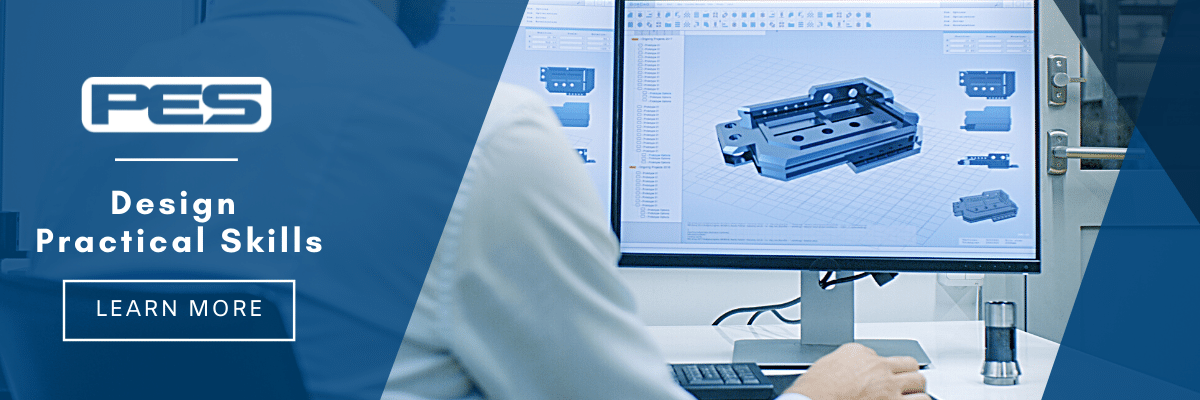.png?width=1200&height=600&name=Facebook%20-%20Featured%20Image%20-%20PES%20(1).png)
Drafters have always been at the forefront of design and innovation. With their unique skill set, they play a pivotal role in designing products, architecture, and industrial buildings that shape our world. As they adapt to technological advancements, drafters are finding that their capabilities are more valuable than ever before. Now, careers in drafting are not only about expertise in creating detailed plans but also about leveraging technology to bring these designs to life.
Whether you choose to specialize in areas like civil engineering, mechanical engineering, or even commercial construction, you will find that with the right skills, you will be employable and in high demand. With experience and a firm basis in education, you'll discover that your drafting abilities are translatable across the nation and even abroad if you're looking for new challenges and possibilities.
- The Evolution of Drafting
- How Technology Impacts Mechanical Drafting Careers
- Bridging the Skill Gap with the PES Training Program
- Finding Success with the PES Training Program
The Evolution of Drafting
From Pen and Paper to CAD (Computer Aided Drafting)
Historical drafters used boards and templates to produce rough sketches on paper and then refined them into more detailed versions. Highly exact drawings could be made using various tools, and these hand-drawn drafts have been trusted in the drafting business over the years. Like most disciplines, drafting has evolved through technology over the years.
The journey from pen and paper to computer-aided design (CAD) reflects the broader technological shifts in the industry. Traditional methods of mechanical drafting, while foundational, have given way to sophisticated mechanical drafting services empowered by digital solutions. These advanced tools are reshaping the landscape of designing drafting and mechanical design, offering unparalleled precision and efficiency.
Advantages of CAD in Drafting:
- Eliminates human error
- Faster and more efficient processes
- Automation
- More time for creativity and problem solving
- Increased project capacity and engagement
- Saved design data
- Better quality work
How Technology Impacts Mechanical Drafting Careers
Integration of Advanced Software:
Modern drafting, especially mechanical drafting, now requires proficiency in sophisticated CAD software. This software has changed the face of designing drafting services, allowing drafters to create highly precise models that can be easily modified. Tools like AutoCAD, SolidWorks, and Revit have become standard in the industry, providing an array of features from 3D modeling to simulation.
Precision and Efficiency:
The precision of CAD in mechanical drafting cannot be overstated. With CAD, mechanical design is now more accurate, significantly reducing the margin for error compared to traditional drafting methods. This precision has led to efficiency in creating detailed drafts, schematics, and part assemblies, ultimately enhancing productivity in mechanical drafting services.
Collaboration and Remote Working:
Technology has also enabled drafters to work collaboratively from various locations. Cloud-based CAD platforms allow for real-time sharing and editing of drafts, making the coordination of large-scale projects smoother and more dynamic. This opens up opportunities for remote work and international collaboration, broadening the job market for drafters globally.
Training and Skill Development:
The need for continuous learning and development in software proficiency has become crucial. Programs like the PES Training Program are tailored to arm designers with hands-on experience using the latest technologies. Such programs are pivotal in keeping aspiring and current professionals competitive in the job market.
Bridging the Skill Gap with the PES Training Program
Understanding the significance of technological fluency in modern drafting, the PES Training Program emerges as a key player in educating and empowering today’s design professionals. This program is more than just a training course—it is a gateway to mastering the digital tools that are now integral to the drafting profession.
Tailored to the Aspiring Drafter
For those motivated to excel in the field of mechanical drafting, the PES Training Program offers invaluable benefits:
- Hands-on Experience: Learn through doing, with exercises that mimic real-world challenges.
- Advanced Software Training: Get trained on the latest CAD software that is transforming the industry.
- Expert-Led Sessions: Benefit from the knowledge and insights of industry experts.
- Job Opportunities: Stand out as a candidate for both full-time and part-time roles within PES, thanks to the competitive edge the program provides, and get compensated based on high performing talent.
- Portfolio Development: Build a robust portfolio that showcases your skills and projects to potential employers.
- Networking: Connect with professionals and grow your industry contacts through the program.
A Leap Beyond Conventional Education
Traditional college programs often lag behind the rapid pace of technological change in professional environments. The PES Training Program fills this gap by offering up-to-date, practical training that is more aligned with what drafters will encounter in the field than many textbook-based approaches.
Even if participants choose not to pursue opportunities with PES directly, the experience and training they receive are incomparable. It positions them as top-tier candidates for various mechanical drafting roles across the industry. Plus, the program keeps resumes on file, potentially opening doors to future opportunities.
Incentivizing Growth and Excellence
By providing an incentive-based learning environment, the PES Training Program does more than educate; it motivates. It pushes participants to develop a problem-solving mindset that is prized in the drafting field—a mindset that sees challenges as opportunities to innovate and excel.
Finding Success with the PES Training Program
As technology continues to redefine the field of drafting, the PES Training Program stands as a critical resource for drafters looking to advance their careers. Whether you are just starting or aiming to update your skills in line with the latest industry standards, this program offers the tools, experience, and connections to help you succeed. Embracing such opportunities is the key to not just keeping pace with the changing landscape of mechanical drafting but leading the charge into the future of design.
Are you ready to make a career change and seeking for practical experience? Are you an entry-level college intern ready learn more about the real world and practical challenges? Learn more about the real-world designing and engineering applications. Sign up today!
About Practical Engineering Solutions
Practical Engineering Solutions will always be dedicated to providing top-notch customer service to meet our industry demands.We set ourselves apart with our consistency and timely turnarounds. We are always committed to being responsive to our clients, KEEPING OUR PROMISES, making delivery schedules, and standing by our designs!
From concept, design, and engineering, to project management and integrity services. We are your gateway to your journey's engineering endeavors. Including oil & gas, hemp & CBD, and food industries.
Providing services focusing in Facilities Engineering, Turn-Key Solutions, Hemp Facilities, Food Plant Engineering, Manufacturing, Engineering Services, Drafting & Design, and Inspection Services.



